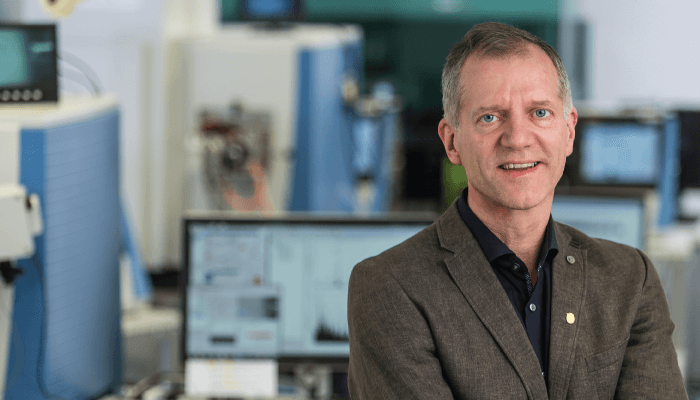
I’m immersed in developing proteomic technologies – and understanding how these precision tools can impact the study of cancer and other diseases. However, we are also very concerned with the ethics around the applied use of proteomics. Technology is advancing at pace, and it is imperative that we stop to consider the ethical implications of our efforts, and how, importantly, this is put into practice.
Throughout my career I have mostly been driven by technology. For instance, as a PhD student I was intrigued by how mass spectrometry works and how this could be applied to studying biology, which was not as commonplace then as it is today. Some 30 years on, the technology has advanced considerably, and we are able to interrogate more and more complex systems. This forward motion shows no sign of abating, and it still captures my attention just as much now as it did when I was a PhD student.
I had a chance encounter with a visiting professor – John B. Fenn – from Yale whilst studying for my master’s degree at the Max Planck Institute in Goettingen. He encouraged me to move with him to undertake a PhD. He is the inventor of the electrospray ionization technique for the analysis of biological macromolecules, and was awarded the Nobel Prize in Chemistry in 2002 – making this choice in my career a particularly fortuitous one!
I realized that, though physics and chemistry were well served by this kind of technology, John had demonstrated applications that stretched into biology – a very underserved discipline.
Molecular biologists at the time were starting to unravel complex biological processes, which required understanding and characterizing specific proteins. They would painstakingly purify the proteins using gels only to struggle with analysis because they only had access to techniques that required a lot of source material. And unfortunately, gels were not compatible with MS. We figured out how to make these proteins available for MS, devised the nano-electrospray technique to increase sensitivity and created peptide sequence tags to allow protein identification. With the human genome sequencing project underway, we were able to identify various proteins for the first time, including telomerase and key proteins in the immune system.
Computing power has ramped up significantly over the years. I’m somewhat unusual in that I come from a physics and mathematical background, which has stood me in good stead when it comes to harnessing such advances. I could write new algorithms and programs to handle complex MS data. I would say my perspective – very much shaped by my multi-disciplinary background – has helped me see biological problems in a different way and given me the ability to drive the technology forward.
We work with and derive interaction maps that highlight the connections between various biological systems. It’s basically network analysis – akin to the social network mapping used by Google and the likes. One such map is the protein interaction map, where protein–protein interactions can be mapped to help elucidate their function.
We became involved in a project to map a whole organism – the “holy grail” of interaction mapping! A network describing a cell is already in place and we have since been involved with repeating this work for a significantly more complex yeast cell. This work illustrates the progress the field has made in the last 20 years. Modern advances have allowed us to analyze these interactions using a fraction of the material required previously – and at much greater speeds and resolution. The impact of this progress is seen in human biology, where a newly identified protein can be dropped into a map to shed light on its possible function and utility. The next step is to explore these maps in a dynamic process, during some cellular activity or response over a specific timeline.
The multiple waves of COVID certainly spurred us to see what our technology could add to the research landscape. In a fruitful collaboration, we used COVID-infected cell cultures to look at what was happening in the infected cell, including post-translational modifications. We discovered that the virus uses cellular proteins to modify its own, which was not known at the time. We also looked at the interaction map to determine which proteins were interacting with which. These findings led to the postulation that some drugs could be repurposed for fighting COVID-19. We are also investigating patient body fluids and post-mortem tissues to aid disease prognosis and tissue specific mechanisms.
Proteomics has developed greatly over the last 20 years or so, with many good research groups in the field, coupled to the emergence of enhanced computer power and commercial collaborations. However, we still have a long way to go. However, even now we have higher sensitivity, we can mine a wider range of data and, critically, we need less sample. Modern techniques have a real clinical utility as a small blood sample can be analyzed as a diagnostic for diseases. Such an approach can also be prognostic; for instance, where a breast or prostate cancer has not yet manifested but the patient is predisposed to such changes. These techniques may be used in determining the potential severity of the disease and inform better treatment stratagems. But such a direction calls into focus the ethical positioning of such tests as we do not want to over-diagnose. The specificity and sensitivity of the test is critical to make it ethical to use such tests, especially when screening a large number of people.
The students and post-docs! They have helped support and pave the way for all these exciting developments, and the very complexity we see in these systems is there for them to unravel in the future.




